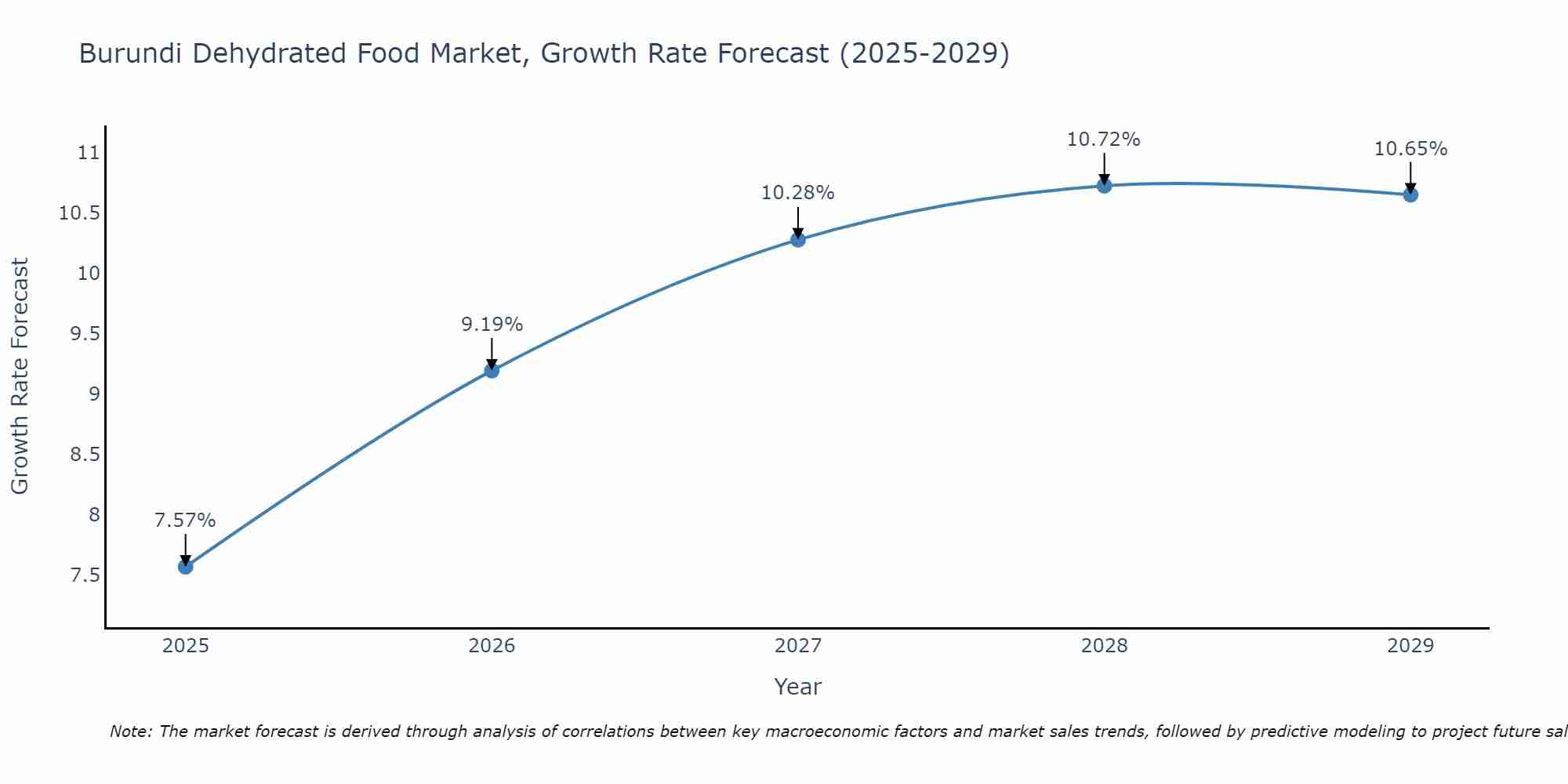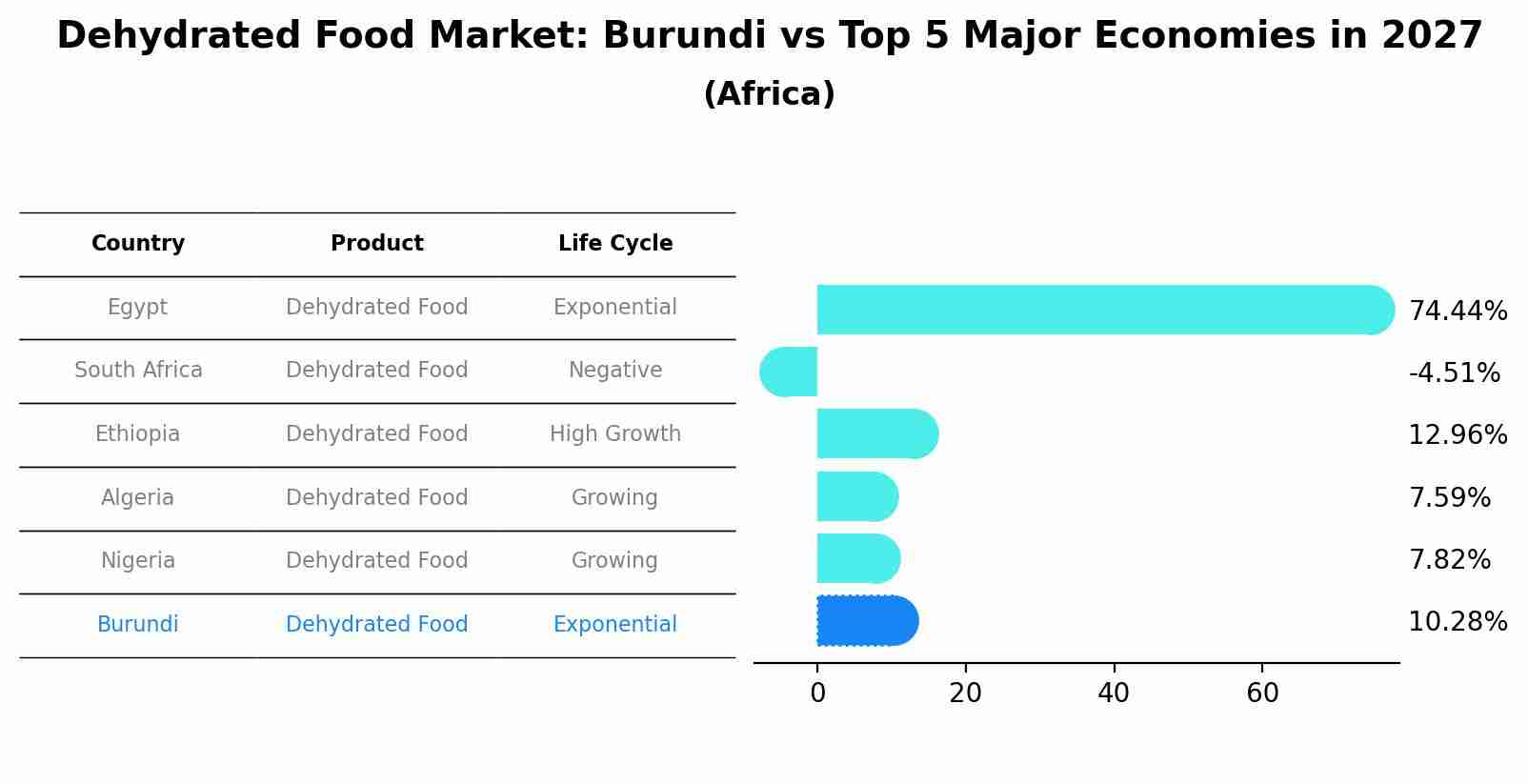Burundi Dehydrated Food Market (2025-2031) | Industry, Segmentation, Share, Companies, Growth, Outlook, Revenue, Forecast, Trends, Value, Size & Analysis
| Product Code: ETC4837223 | Publication Date: Nov 2023 | Updated Date: Apr 2025 | Product Type: Market Research Report | |
| Publisher: 6Wresearch | Author: Sachin Kumar Rai | No. of Pages: 60 | No. of Figures: 30 | No. of Tables: 5 |
Burundi Dehydrated Food Market Size Growth Rate
The Burundi Dehydrated Food Market is projected to witness mixed growth rate patterns during 2025 to 2029. Starting at 7.57% in 2025, the market peaks at 10.72% in 2028, and settles at 10.65% by 2029.

Dehydrated Food Market: Burundi vs Top 5 Major Economies in 2027 (Africa)
By 2027, Burundi's Dehydrated Food market is forecasted to achieve a high growth rate of 10.28%, with Egypt leading the Africa region, followed by South Africa, Ethiopia, Algeria and Nigeria.

Burundi Dehydrated Food Market Overview
The Dehydrated Food Market in Burundi is gradually expanding as more consumers and businesses seek convenient, long-lasting food products. Dehydrated foods, which include fruits, vegetables, and meals, are gaining popularity due to their extended shelf life and ease of storage, making them ideal for both everyday use and emergency situations.
/h3
The Burundi Dehydrated Food Market is experiencing growth due to the rising demand for convenient and long-lasting food products. Dehydrated foods offer extended shelf life and easy storage, making them popular among consumers in both urban and rural areas. The increasing urbanization, changing lifestyles, and growing awareness of food preservation techniques are key factors driving the market for dehydrated foods in Burundi.
/h3
The dehydrated food market in Burundi faces significant challenges, primarily driven by infrastructure limitations and the high cost of technology required for food dehydration processes. The lack of cold storage facilities and efficient supply chains exacerbates post-harvest losses, limiting the availability of raw materials for dehydration. Additionally, the limited consumer awareness and acceptance of dehydrated food products pose a barrier to market growth, as traditional preferences dominate. Moreover, the industry struggles with insufficient investment and governmental support, which hampers efforts to scale operations and adopt modern dehydration technologies, thereby stunting the market`s potential.
/h3
Government policies impacting the dehydrated food market in Burundi focus on food safety and agricultural development. Regulations support the production and distribution of dehydrated foods by setting standards for quality and safety. The government promotes the use of dehydrated foods through incentives for businesses in the food processing and agriculture sectors. Policies aimed at improving food security and supporting agricultural innovation further influence the dehydrated food market, fostering growth and sustainability.
Key Highlights of the Report:
- Burundi Dehydrated Food Market Outlook
- Market Size of Burundi Dehydrated Food Market, 2024
- Forecast of Burundi Dehydrated Food Market, 2031
- Historical Data and Forecast of Burundi Dehydrated Food Revenues & Volume for the Period 2021-2031
- Burundi Dehydrated Food Market Trend Evolution
- Burundi Dehydrated Food Market Drivers and Challenges
- Burundi Dehydrated Food Price Trends
- Burundi Dehydrated Food Porter`s Five Forces
- Burundi Dehydrated Food Industry Life Cycle
- Historical Data and Forecast of Burundi Dehydrated Food Market Revenues & Volume By Type for the Period 2021-2031
- Historical Data and Forecast of Burundi Dehydrated Food Market Revenues & Volume By Spray-dried for the Period 2021-2031
- Historical Data and Forecast of Burundi Dehydrated Food Market Revenues & Volume By Freeze-dried for the Period 2021-2031
- Historical Data and Forecast of Burundi Dehydrated Food Market Revenues & Volume By Vacuum-dried for the Period 2021-2031
- Historical Data and Forecast of Burundi Dehydrated Food Market Revenues & Volume By Drum-dried for the Period 2021-2031
- Historical Data and Forecast of Burundi Dehydrated Food Market Revenues & Volume By Others for the Period 2021-2031
- Historical Data and Forecast of Burundi Dehydrated Food Market Revenues & Volume By Product for the Period 2021-2031
- Historical Data and Forecast of Burundi Dehydrated Food Market Revenues & Volume By Dried Processed Food for the Period 2021-2031
- Historical Data and Forecast of Burundi Dehydrated Food Market Revenues & Volume By Dried Fruit & Vegetable for the Period 2021-2031
- Historical Data and Forecast of Burundi Dehydrated Food Market Revenues & Volume By Dried Dairy for the Period 2021-2031
- Historical Data and Forecast of Burundi Dehydrated Food Market Revenues & Volume By Dried Meat & Seafood for the Period 2021-2031
- Historical Data and Forecast of Burundi Dehydrated Food Market Revenues & Volume By Others for the Period 2021-2031
- Historical Data and Forecast of Burundi Dehydrated Food Market Revenues & Volume By Distribution Channel for the Period 2021-2031
- Historical Data and Forecast of Burundi Dehydrated Food Market Revenues & Volume By Hypermarket/Supermarket for the Period 2021-2031
- Historical Data and Forecast of Burundi Dehydrated Food Market Revenues & Volume By Convenience Stores for the Period 2021-2031
- Historical Data and Forecast of Burundi Dehydrated Food Market Revenues & Volume By Online Retailing for the Period 2021-2031
- Historical Data and Forecast of Burundi Dehydrated Food Market Revenues & Volume By Others for the Period 2021-2031
- Burundi Dehydrated Food Import Export Trade Statistics
- Market Opportunity Assessment By Type
- Market Opportunity Assessment By Product
- Market Opportunity Assessment By Distribution Channel
- Burundi Dehydrated Food Top Companies Market Share
- Burundi Dehydrated Food Competitive Benchmarking By Technical and Operational Parameters
- Burundi Dehydrated Food Company Profiles
- Burundi Dehydrated Food Key Strategic Recommendations
Frequently Asked Questions About the Market Study (FAQs):
1 Executive Summary |
2 Introduction |
2.1 Key Highlights of the Report |
2.2 Report Description |
2.3 Market Scope & Segmentation |
2.4 Research Methodology |
2.5 Assumptions |
3 Burundi Dehydrated Food Market Overview |
3.1 Burundi Country Macro Economic Indicators |
3.2 Burundi Dehydrated Food Market Revenues & Volume, 2021 & 2031F |
3.3 Burundi Dehydrated Food Market - Industry Life Cycle |
3.4 Burundi Dehydrated Food Market - Porter's Five Forces |
3.5 Burundi Dehydrated Food Market Revenues & Volume Share, By Type, 2021 & 2031F |
3.6 Burundi Dehydrated Food Market Revenues & Volume Share, By Product, 2021 & 2031F |
3.7 Burundi Dehydrated Food Market Revenues & Volume Share, By Distribution Channel, 2021 & 2031F |
4 Burundi Dehydrated Food Market Dynamics |
4.1 Impact Analysis |
4.2 Market Drivers |
4.3 Market Restraints |
5 Burundi Dehydrated Food Market Trends |
6 Burundi Dehydrated Food Market Segmentations |
6.1 Burundi Dehydrated Food Market, By Type |
6.1.1 Overview and Analysis |
6.1.2 Burundi Dehydrated Food Market Revenues & Volume, By Spray-dried, 2021-2031F |
6.1.3 Burundi Dehydrated Food Market Revenues & Volume, By Freeze-dried, 2021-2031F |
6.1.4 Burundi Dehydrated Food Market Revenues & Volume, By Vacuum-dried, 2021-2031F |
6.1.5 Burundi Dehydrated Food Market Revenues & Volume, By Drum-dried, 2021-2031F |
6.1.6 Burundi Dehydrated Food Market Revenues & Volume, By Others, 2021-2031F |
6.2 Burundi Dehydrated Food Market, By Product |
6.2.1 Overview and Analysis |
6.2.2 Burundi Dehydrated Food Market Revenues & Volume, By Dried Processed Food, 2021-2031F | 6.2.3 Burundi Dehydrated Food Market Revenues & Volume, By Dried Fruit & Vegetable, 2021-2031F |
6.2.4 Burundi Dehydrated Food Market Revenues & Volume, By Dried Dairy, 2021-2031F |
6.2.5 Burundi Dehydrated Food Market Revenues & Volume, By Dried Meat & Seafood, 2021-2031F |
6.2.6 Burundi Dehydrated Food Market Revenues & Volume, By Others, 2021-2031F |
6.3 Burundi Dehydrated Food Market, By Distribution Channel |
6.3.1 Overview and Analysis |
6.3.2 Burundi Dehydrated Food Market Revenues & Volume, By Hypermarket/Supermarket, 2021-2031F |
6.3.3 Burundi Dehydrated Food Market Revenues & Volume, By Convenience Stores, 2021-2031F |
6.3.4 Burundi Dehydrated Food Market Revenues & Volume, By Online Retailing, 2021-2031F |
6.3.5 Burundi Dehydrated Food Market Revenues & Volume, By Others, 2021-2031F |
7 Burundi Dehydrated Food Market Import-Export Trade Statistics |
7.1 Burundi Dehydrated Food Market Export to Major Countries |
7.2 Burundi Dehydrated Food Market Imports from Major Countries |
8 Burundi Dehydrated Food Market Key Performance Indicators |
9 Burundi Dehydrated Food Market - Opportunity Assessment |
9.1 Burundi Dehydrated Food Market Opportunity Assessment, By Type, 2021 & 2031F |
9.2 Burundi Dehydrated Food Market Opportunity Assessment, By Product, 2021 & 2031F |
9.3 Burundi Dehydrated Food Market Opportunity Assessment, By Distribution Channel, 2021 & 2031F |
10 Burundi Dehydrated Food Market - Competitive Landscape |
10.1 Burundi Dehydrated Food Market Revenue Share, By Companies, 2024 |
10.2 Burundi Dehydrated Food Market Competitive Benchmarking, By Operating and Technical Parameters |
11 Company Profiles |
12 Recommendations | 13 Disclaimer |
- Single User License$ 1,995
- Department License$ 2,400
- Site License$ 3,120
- Global License$ 3,795
Search
Related Reports
- Portugal Electronic Document Management Market (2025-2031) | Strategy, Consumer Insights, Analysis, Investment Trends, Opportunities, Growth, Size, Share, Industry, Revenue, Segments, Value, Segmentation, Supply, Forecast, Restraints, Outlook, Competition, Drivers, Trends, Demand, Pricing Analysis, Competitive, Strategic Insights, Companies, Challenges
- France Electronic Document Management Market (2025-2031) | Strategy, Consumer Insights, Analysis, Investment Trends, Opportunities, Growth, Size, Share, Industry, Revenue, Segments, Value, Segmentation, Supply, Forecast, Restraints, Outlook, Competition, Drivers, Trends, Demand, Pricing Analysis, Competitive, Strategic Insights, Companies, Challenges
- Portugal Occupational Health & Safety Services Market (2025-2031) | Strategy, Consumer Insights, Analysis, Investment Trends, Opportunities, Growth, Size, Share, Industry, Revenue, Segments, Value, Segmentation, Supply, Forecast, Restraints, Outlook, Competition, Drivers, Trends, Demand, Pricing Analysis, Competitive, Strategic Insights, Companies, Challenges
- Netherlands Occupational Health and Safety Services Market (2025-2031) | Strategy, Consumer Insights, Analysis, Investment Trends, Opportunities, Growth, Size, Share, Industry, Revenue, Segments, Value, Segmentation, Supply, Forecast, Restraints, Outlook, Competition, Drivers, Trends, Demand, Pricing Analysis, Competitive, Strategic Insights, Companies, Challenges
- Belgium and Luxembourg Facility Management Market (2025-2031) | Strategy, Consumer Insights, Analysis, Investment Trends, Opportunities, Growth, Size, Share, Industry, Revenue, Segments, Value, Segmentation, Supply, Forecast, Restraints, Outlook, Competition, Drivers, Trends, Demand, Pricing Analysis, Competitive, Strategic Insights, Companies, Challenges
- Russia Women Intimate Apparel Market (2025-2031) | Strategy, Consumer Insights, Analysis, Investment Trends, Opportunities, Growth, Size, Share, Industry, Revenue, Segments, Value, Segmentation, Supply, Forecast, Restraints, Outlook, Competition, Drivers, Trends, Demand, Pricing Analysis, Competitive, Strategic Insights, Companies, Challenges
- Africa Chocolate Market (2025-2031) | Size, Share, Trends, Growth, Revenue, Analysis, Forecast, industry & Outlook
- Global Hydroxychloroquine And Chloroquine Market (2025-2031) | Industry, Trends, Size, Outlook, Growth, Value, Companies, Revenue, Analysis, Share, Forecast
- Saudi Arabia Plant Maintenance Market (2025-2031) | Industry, Size, Growth, Revenue, Value, Companies, Forecast, Analysis, Share & Trends
- Taiwan Electric Truck Market (2025-2031) | Outlook, Industry, Revenue, Size, Forecast, Growth, Analysis, Share, Companies, Value & Trends
Industry Events and Analyst Meet
Our Clients
Whitepaper
- Middle East & Africa Commercial Security Market Click here to view more.
- Middle East & Africa Fire Safety Systems & Equipment Market Click here to view more.
- GCC Drone Market Click here to view more.
- Middle East Lighting Fixture Market Click here to view more.
- GCC Physical & Perimeter Security Market Click here to view more.
6WResearch In News
- Doha a strategic location for EV manufacturing hub: IPA Qatar
- Demand for luxury TVs surging in the GCC, says Samsung
- Empowering Growth: The Thriving Journey of Bangladesh’s Cable Industry
- Demand for luxury TVs surging in the GCC, says Samsung
- Video call with a traditional healer? Once unthinkable, it’s now common in South Africa
- Intelligent Buildings To Smooth GCC’s Path To Net Zero













